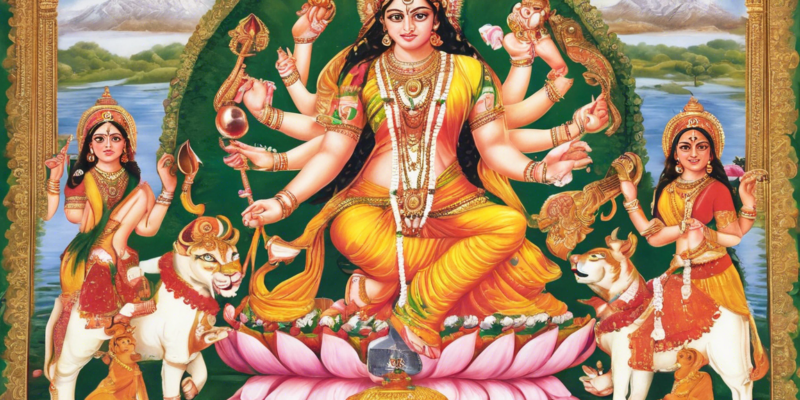Introduction
In the realm of Hindu spirituality, the Durga Saptashati holds a revered position as a sacred scripture that is known for its profound spiritual significance and transformative power. Also known as the Devi Mahatmyam or Chandi Path, this ancient text is a collection of 700 verses in praise of Goddess Durga, extolling her various forms and attributes. The Durga Saptashati is not merely a scriptural text but is considered a potent tool for invoking the blessings of the Divine Feminine for protection, prosperity, and spiritual growth. In this comprehensive guide, we will delve deep into the essence of the Durga Saptashati, its historical context, significance, and the ways in which it can be utilized for spiritual upliftment.
Historical Context and Origin
The origins of the Durga Saptashati can be traced back to the Markandeya Purana, a revered ancient text that narrates the stories and glories of the Goddess Durga. Composed in Sanskrit, the Durga Saptashati is structured into three distinct chapters, each known as a ‘Charit’. These chapters chronicle the battles of the Goddess against various demonic forces, symbolizing the eternal struggle between good and evil, light and darkness. The central narrative revolves around the defeat of the buffalo-demon Mahishasura by Goddess Durga, thereby earning her the title of ‘Mahishasura Mardini’, the slayer of Mahishasura.
Significance of the Durga Saptashati
The Durga Saptashati is revered for its multifaceted significance, serving as a spiritual guide, a hymn of devotion, and a source of divine protection. Some of the key aspects that highlight the significance of this sacred text include:
-
Invoke Divine Energy: The recitation of the Durga Saptashati is believed to invoke the divine energy of Goddess Durga, bestowing the devotee with courage, strength, and protection.
-
Overcoming Obstacles: The verses of the Durga Saptashati are considered potent in overcoming obstacles, both physical and spiritual, thereby paving the way for success and prosperity.
-
Spiritual Evolution: By contemplating upon the divine qualities of Goddess Durga as described in the Saptashati, one can embark on a journey of spiritual evolution and self-transformation.
-
Protection and Blessings: The Durga Saptashati is often recited for seeking protection from negative forces, warding off evil influences, and seeking the blessings of the Goddess for overall well-being.
-
Fulfillment of Desires: Devotees believe that sincere devotion and regular recitation of the Durga Saptashati can lead to the fulfillment of desires and aspirations, aligning their lives with divine will.
Structure and Verses of the Durga Saptashati
The Durga Saptashati is divided into three sections, each known as a ‘Charit’, corresponding to a specific theme and aspect of Goddess Durga’s manifestations. The first chapter, known as the ‘Madhu Kaitabha Vadha’, narrates the slaying of the demons Madhu and Kaitabha by the Goddess. The second chapter, ‘Mahishasura Mardini’, details the epic battle between Goddess Durga and the buffalo-demon Mahishasura. The third chapter, ‘Dhoomavati Jayanti’, celebrates the victory of the Goddess over the demons Shumbha and Nishumbha.
The Durga Saptashati is replete with powerful verses that extol the virtues and forms of Goddess Durga. Each verse not only praises the divine qualities of the Goddess but also serves as a mantra that resonates with specific energies and vibrations. Devotees often recite these verses with devotion and sincerity to establish a sacred connection with the Goddess and invite her divine grace into their lives.
Methods of Recitation
The Durga Saptashati can be recited in various ways, each method offering unique benefits and spiritual rewards. Some of the common practices of reciting the Durga Saptashati include:
-
Parayana: This method involves the systematic recitation of the entire Durga Saptashati in a continuous manner, either in a single sitting or over a span of days. Parayana is believed to be highly meritorious and can yield immense spiritual benefits.
-
Adhyay Path: Adhyay Path refers to the practice of reciting one chapter of the Durga Saptashati each day, thereby completing the entire text in three days. This method is considered auspicious and is often undertaken during Navaratri, the nine-day festival dedicated to Goddess Durga.
-
Phalashruti: After the completion of the recitation, devotees often read the ‘Phalashruti’, a section that describes the benefits and blessings one can attain by reverentially studying the Durga Saptashati. This serves as a culmination of the spiritual practice and reinforces the divine grace of the Goddess.
-
Homam: In addition to recitation, some devotees perform a ‘Chandi Homa’, a sacred fire ritual dedicated to Goddess Chandi, to amplify the spiritual potency of the Durga Saptashati. The Homa is performed with specific invocations and offerings, invoking the presence of the Goddess in the sacrificial fire.
Benefits of Reciting the Durga Saptashati
The recitation of the Durga Saptashati is believed to bestow a multitude of benefits on the devotee, both on the material and spiritual planes. Some of the key benefits of reciting the Durga Saptashati include:
-
Protection and Healing: The verses of the Durga Saptashati serve as a shield of divine protection, guarding the devotee against negative forces and fostering physical, emotional, and spiritual healing.
-
Removal of Obstacles: By seeking the blessings of Goddess Durga through regular recitation, devotees can overcome obstacles, challenges, and adversities in their lives, paving the way for success and prosperity.
-
Spiritual Upliftment: The Durga Saptashati acts as a catalyst for spiritual growth and evolution, helping the devotee transcend their limitations, purify their consciousness, and deepen their connection with the Divine.
-
Fulfillment of Desires: Devout recitation of the Durga Saptashati with faith and devotion is believed to fulfill the heartfelt desires and aspirations of the devotee, aligning their will with the divine will of the Goddess.
-
Blessings of the Goddess: Ultimately, the greatest benefit of reciting the Durga Saptashati is the opportunity to receive the abundant blessings, grace, and love of the Goddess Durga, nurturing one’s spiritual journey and guiding them towards ultimate liberation.
Tips for Effective Recitation
To derive maximum benefit from the recitation of the Durga Saptashati, it is essential to approach the practice with sincerity, devotion, and reverence. Here are some tips for effective recitation:
-
Maintain Purity: Before beginning the recitation, purify the mind, body, and surroundings by bathing, wearing clean clothes, and setting up a sacred space with a picture or idol of Goddess Durga.
-
Set an Intention: Before each session of recitation, set a clear intention or prayer in your heart, expressing your sincere devotion and seeking the blessings of the Goddess for a specific purpose or goal.
-
Recite with Devotion: Chant the verses of the Durga Saptashati with utmost devotion, focus, and concentration, allowing the divine vibrations of the mantras to resonate within you and create a profound impact.
-
Regular Practice: Establish a consistent practice of reciting the Durga Saptashati, whether daily, weekly, or on special occasions, to maintain a deep connection with the Goddess and experience continuous spiritual upliftment.
-
Reflect and Contemplate: After each recitation, take a few moments to reflect on the divine qualities of Goddess Durga described in the verses and contemplate on how you can imbibe those virtues in your own life.
-
Offer Prayers and Offerings: Conclude each recitation with heartfelt prayers, invocations, and offerings of flowers, incense, or fruits to express your gratitude to the Goddess and seek her continued blessings.
By following these tips and guidelines, devotees can enhance their spiritual practice of reciting the Durga Saptashati and unlock its transformative power for personal growth and divine connection.
FAQs (Frequently Asked Questions)
1. What is the best time to recite the Durga Saptashati?
– The early morning hours, known as ‘Brahma Muhurta’, are considered auspicious for reciting the Durga Saptashati. Alternatively, one can choose a time that is convenient and conducive for their spiritual practice.
2. Can men also recite the Durga Saptashati?
– Yes, the Durga Saptashati can be recited by individuals of all genders. The divine energy of Goddess Durga is all-encompassing and bestows blessings without any discrimination.
3. How long does it take to complete the recitation of the Durga Saptashati?
– The time taken to complete the recitation of the Durga Saptashati can vary depending on the method chosen. While some may complete it in a few hours, others may spread it over several days or weeks.
4. Is it mandatory to understand the meaning of the verses while reciting the Durga Saptashati?
– While understanding the meaning of the verses can deepen one’s connection and reverence towards the Goddess, it is not mandatory. The sincere recitation with faith and devotion is equally powerful.
5. Can the Durga Saptashati be recited during menstruation?
– Women are traditionally advised not to recite sacred texts, including the Durga Saptashati, during menstruation due to reasons related to purity and energy levels. It is advisable to refrain from recitation during this time.
6. Can the Durga Saptashati be recited for specific intentions or purposes?
– Yes, devotees can recite the Durga Saptashati with specific intentions such as seeking protection, healing, success, or spiritual growth. Setting clear intentions can amplify the efficacy of the recitation.
7. Are there any dietary restrictions to be followed during the recitation of the Durga Saptashati?
– While there are no strict dietary restrictions, it is advisable to maintain a sattvic (pure and balanced) diet, avoid consuming non-vegetarian food, alcohol, and other tamasic (impure) substances during the period of recitation.
8. Can the Durga Saptashati be recited by children?
– Children can certainly be encouraged to listen to the recitation of the Durga Saptashati or chant specific verses under adult supervision. It can instill a sense of devotion and spiritual connection in them from a young age.
9. What should one do if they miss a day of recitation during the Adhyay Path?
– In case a day of recitation is missed during the Adhyay Path, devotees can either make up for it by reciting two chapters on another day or extend the practice by an additional day to ensure completion.
10. Can the Durga Saptashati be recited for someone else’s well-being?
– Yes, the Durga Saptashati can be recited on behalf of someone else as a gesture of compassion and goodwill. Devotees can offer the merits of their recitation for the well-being and blessings of others.
In conclusion, the Durga Saptashati stands as a potent scripture that encapsulates the divine glory and benevolence of Goddess Durga. By immersing oneself in the verses of this sacred text with faith, devotion, and reverence, one can unlock the transformative power of the Goddess, receive her abundant blessings, and traverse the path of spiritual evolution and realization.



Comments